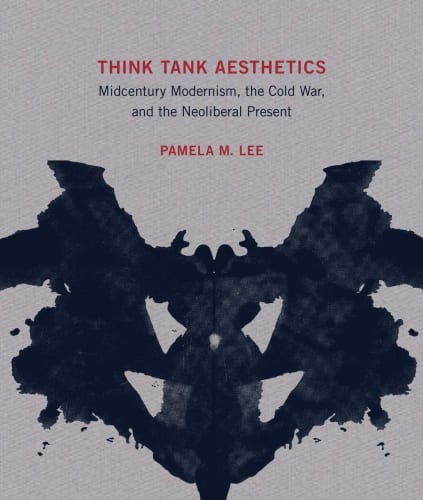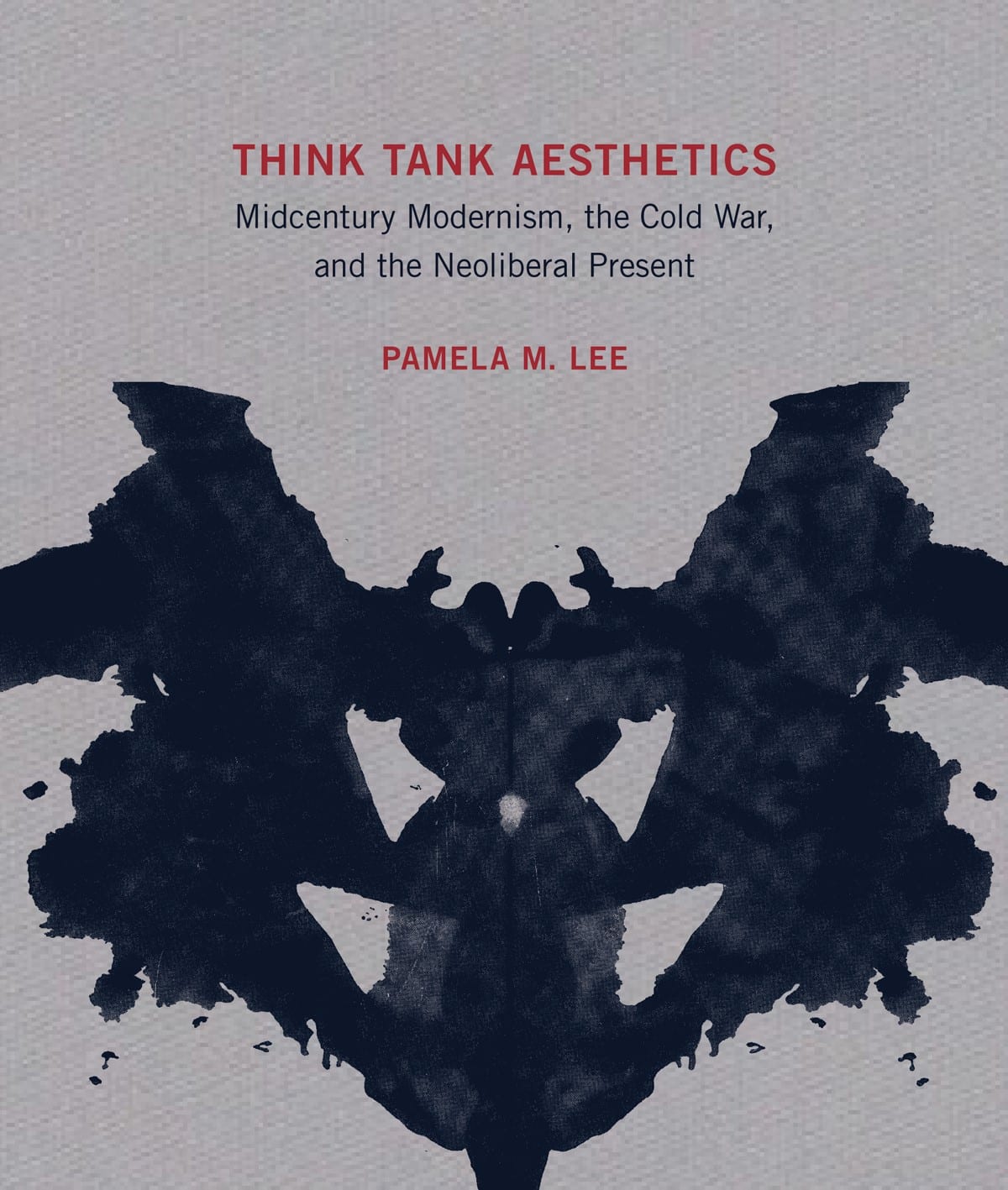From Art Journal 80, no. 1 (Spring 2021)
Pamela M. Lee. Think Tank Aesthetics: Midcentury Modernism, the Cold War, and the Neoliberal Present. Cambridge, MA: MIT Press, 2020. 360 pp.; 15 color ills., 54 b/w. $35

“Sensibilities,” “aesthetics,” “think tanks”—these are terms you rarely see combined in the same sentence or paragraph, although one might imagine such a turn of phrase in one of Joan Didion’s journalistic forays into the more arcane realms of politics. Yet the argument in Pamela M. Lee’s book is that, given the peculiar nature of think tanks, they actually should be. Using the terminologies typical of art and art history to describe a political institution might come across as fuzziness of the first order—but then again, the fuzzy or vague is precisely the point here. For while the “tank” in “think tank” conjures images of a contained, circumscribed entity, think tanks are in fact anything but. Originating in the mid-nineteenth century, they are extra-academic and parapolitical research institutions that became a prominent part of the American political and intellectual landscape during the Cold War era (today they are ubiquitous across the globe). Untroubled by the disciplinary mandates and scholarly claims to objectivity marking standard academic research, they carved out a new and highly ambiguous ground in which partisanship, realpolitik, experimentation, and eclecticism were harnessed to the project of problem solving and opinion forming within the larger fields of interest defined by their sponsors. They were, in short, political and institutional spearheads for the interdisciplinarity and boundlessness that also emerged as key aesthetic values in radical art production during the same period. However, in this study think tanks and artistic productions are not treated as parallel instantiations of the same set of ideas. What Lee documents, and in compelling detail, is the think tank as the site of a remarkable imbrication of art and politics, ambiguously united through a unique propensity for, and ability to operationalize, ambiguity as such.
The object of this art historical study is therefore not works of art, or art “in context,” but rather a sensibility—a particular aesthetic orientation: hence the emphasis on the essentially ambient—one could even say atmospheric—character of the phenomena under discussion. It is, more specifically, a sensibility that underpins the development and increasing influence of neoliberal thought and that can only be traced by actually studying the murky political-strategic terrain of think tank movers and shakers, in which artists and designers also came to play a role. While most studies of interdisciplinarity in art focus on artistic production and performance, noting extramural collaborations and (uncanny) echoes of neoliberal scenarios, Lee presents interdisciplinary sensibilities at work in actual and conflicted political contexts and wedded to no particular discipline, rather than as claims explored within the circuits of art as such.
As could be expected, this makes for a reading in which it is not always easy to find one’s bearings, and at times one gets the sense that the composition of the text must have presented the author with a few challenges. But the historical think tanks’ promotion of creativity and innovation is also, by now, entirely familiar, and Lee conveys in no uncertain terms how this discursive configuration, fueled by a fundamentally aesthetic appreciation of events, emerged in part through the influence of the new disciplines of cybernetics and information theory and in part by attention to semiotics, futuristic design, and the radical ends of abstract painting. In this narrative, the RAND Corporation in California appears as the paradigmatic institution, in the sense that its overarching focus on defense systems and the strictly technological effort to control the uncontrollable fostered an environment uniquely hospitable to artistic example and collaboration. The impact of its ethos of creativity is palpable in a 1968 paper (not mentioned by Lee), in which a RAND personnel researcher, outlining a public philosophy for real-time information systems, reflects on the way in which such systems, which must be seen as active agents molding a partially plastic environment, may occasion social experimentation on an unprecedented scale and in “a bewildering variety of ways.”1 Lee, for her part, traces the longer historical arc of the RAND ethos by closing in on the thirty-year-long correspondence between art historian Meyer Schapiro and defense strategist Albert Wohlstetter, whose interests converge on the question of visual semiotics. While for the art historian attention to the arbitrary and wavering nature of the sign serves to undermine the strictures of iconography, the defense strategist uses the same form of knowledge to control and intercept the contingency (or polysemy) of the battleground. One man’s liberator is the other man’s enemy; what they share is the tactical deployment of the science of signs. RAND equally played host when anthropologist Margaret Mead, along with her network of academics and art world contacts, was hired to analyze the mindset and character of Soviet Russians through experiments in pattern recognition. Here, a tendency to pseudomorphism symptomatic of a new interest in the relation between fine art and a broader visual culture conflates Rorschach tests and Jackson Pollock paintings as methodological tools in a quest for cultural likeness and identity—a mode of thinking typical of the Cold War era and ultimately serving the interests of military strategy.
This is, however, not just a story about the cultural/political past. As Lee’s narrative unfolds, present-day reverberations of the ambient think tank sensibilities appear with increasing clarity and charge. Exhibit A is Cybersyn, the prototype of a sort of “socialist internet” developed by British cybernetics pioneer Stafford Beer for Salvador Allende—a spectacular space-age-style control room equipped with some five hundred telex machines that was to allow the Chilean government to track their socialist planned economy in real time. Yet the 2009 restaging of this room as a media artwork at ZKM/Center for Art and Media in Karlsruhe, Germany, posits it as a sort of arché, or generative origin, of contemporary neoliberalism—its Bauhaus-inspired futuristic design now underscoring the proximity between this dynamic management tool and the operations research models of economist Friedrich Hayek and other Cold War think tank luminaries that in fact helped overturn Allende’s rule. Exhibit B is even more emphatically located in a present moment in which contemporary artists such as Jamal Cyrus, Trevor Paglen, and Jill Magid, in their different ways, play off a media dynamics in which the phenomenon of leaks—starting with RAND military analyst Daniel Ellsberg’s 1971 release of a huge trove of classified information on the Vietnam War to newspapers—gives political secrets a new and spectacular visibility. Theirs are works that stage or aestheticize contemporary strategies of concealment or censorship, giving form to the liminal fascination for that which hides in plain sight. The think tank itself—presumably haughtily closed off, yet dynamically all over the place—might in fact be a key instance of such liminality.
That such qualities obviously also resonate with the perennially troubled knot of phenomena that is contemporary art speaks to the way in which this brilliantly researched and argued book might actually also be seen as a contribution to recent discussions about close correspondences between artistic and social/economic forms of abstraction. These are, notably, discussions that expand the notion of abstraction in art way beyond the tropes of painterly nonfiguration. What is perhaps missing from this account is a more systematic engagement with the very thing that is key to the book’s thesis, and that is further underscored in the coda on the relationship between the Metropolitan Museum and the David H. Koch Charitable Foundation: the very notion of sensibility as a defining trait of the think tank, at least to the extent that think tanks may be understood as expanding networks of cultural-political associations and effects. In recent years, the field of atmosphere theory that harks back to the work of, among others, Georg Simmel and Walter Benjamin has constantly sharpened its vocabularies and perspectives in order to deal with the vague, fuzzy, or ambient dimensions of that which is collectively held yet escapes precise definition, sense of scale, and cause-and-effect explanation. As Friedlind Riedel has argued, atmospheres are essentially contagious phenomena that bring into appearance that which cannot be deduced from or reduced to the bodies present in a situation or referred to in terms of a single specific source.2 While earlier and more spatially inclined theories of atmospheres could easily be charged with providing a too unitary or coherent notion of social affect (as seen for instance in the idea that atmospheres “reign” over a situation), more recent approaches, such as Derek P. McCormack’s concept of envelopment, see atmospheric “things” as processual fabrications activated through relations among bodies, elemental conditions, and devices/technologies—a perspective that is congenial with the feedback dynamics animating the think tank sensibility.3
To the extent that think tank sensibilities may be a key feature of the globally extended spirit of neoliberalism, it is of course also interesting to note the strong preponderance of atmospheric modes of construction or articulation among the generation of post-1990s artists who shifted attention away from the (by now) more traditional forms of institutional critique in art in order to tackle the more elusive or existential dimensions of the new modes of power and government. Some of them, like Liam Gillick, would even repeatedly evoke the shape-shifting form of the think tank as a general model. Yet, if Lee does not quite go there, her great achievement is to provide a set of sharpened historical and ideological horizons for such discussions.
Ina Blom is professor in the Department of Philosophy, Classics, History of Art and Ideas at the University of Oslo and Wigeland Visiting Professor in the Department of Art History, University of Chicago.
- Harold Sackman, “A Public Philosophy for Real Time Information Systems,” AFIPS Conference Proceedings 33, pt. 2 (1968): 1491–98. ↩
- Friedlind Riedel, “Atmosphere,” in Affective Societies: Key Concepts, ed. Jan Slaby and Christian von Scheve (Abingdon, UK: Routledge, 2019), 85–95. ↩
- Derek P. McCormack, Atmospheric Things: On the Allure of Elemental Envelopment (Durham, NC: Duke University Press, 2018). ↩

